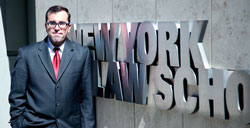Few Jobs, But a Rack of Suits: Law Grads Claim Their Alma Maters Duped Them

David Anziska: Law schools are “not depicting an accurate representation of the marketplace out there.” Photo by Len Irish.
In 2005, Chloe Gilgan bet that obtaining a law degree would guarantee her a competitive salary and a steady career path. Instead, she wound up with a mountain of debt and limited job prospects.
Gilgan, who says she relied heavily on placement data from New York Law School to decide whether to attend, is one of a growing number of law school graduates suing their alma maters.
Their claims of being misled by the schools over employment prospects are wending their way through the courts. They are helping to fuel a highly publicized debate about job placement reporting standards.
“My argument is not that they need to find me a job. My argument is that I relied on statistics,” says Gilgan, 37, a former actress and Columbia University undergraduate who finished New York Law School in the top third of her class.
After passing the bar and finding work that included a stint as a low-paid legal assistant, she has since abandoned a law career in favor of running a small bed-and-breakfast with her husband in the English seaside town of Whitby. Still, she struggles to make monthly payments toward law school loans that, she says, total more than $200,000, part of a consolidated educational-debt burden weighing on her decision to have a second child.
“I’m not looking to win the lottery,” Gilgan says. “I’m looking for some relief because I relied on the ‘facts.’ ”
CHALLENGING SCHOOL STATS
According to Gilgan and eight co-plaintiffs in the suit, which was filed in August, since 2005 New York Law School marketed its placement record within nine months of student graduation as 90 percent or higher. The school didn’t mention that the positions included part-time and nonlegal work, the plaintiffs contend.
“Unfortunately, NYLS’s false and fraudulent representations and omissions are endemic in the law school industry, as nearly every school to a certain degree blatantly manipulates their employment data to make themselves more attractive to prospective students,” they allege in the suit. The plaintiffs cite the school’s push to put its best foot forward for influential rankings such as those published annually in U.S. News & World Report.
The lawsuit—seeking class certification, damages of more than $225 million and reforms to legal employment reporting standards—is one of 15 similar complaints targeting law schools around the country for allegations of fraudulent misrepresentation of employment information. The schools include: Thomas M. Cooley Law School in Lansing, Mich.; Florida Coastal School of Law in Jacksonville; DePaul Univer sity College of Law and IIT Chicago-Kent College of Law, both in Chicago; and Widener University School of Law, with campuses in Wilmington, Del., and Harrisburg, Pa.
The allegations come at a difficult time for the legal industry, which is marked by a steadily declining job market, a dearth of positions for newly minted graduates and a slowdown in law school admission.
According to earlier reports, the Law School Admission Council Inc. said applications were down an average of 11.5 percent for fall 2011 and it saw indications of a continued decline for the fall of 2012.
The plaintiffs’ vocal champion is David Anziska, a class action attorney in New York City whose media exposure regarding the claims has turned him into a minor celebrity. Anziska, who holds a law degree from the University of Michigan Law School, has filed 14 of the suits along with his partner, Jesse Strauss, including 12 in February. In March, he announced plans to go after 20 more schools in 10 states.
“We want to sue as many schools as possible,” Anziska says, noting that his own financial success with short sales in the housing market afforded him the ability to pursue the litigation full time. “It’s very important for us for this to go global, to scale up. We feel that this practice has been a dirty secret for a very long time.”
Even during the recession, he asserts, many law schools were advertising grossly inflated placement rates, when in reality their graduates were frequently struggling to find part-time work reviewing contracts, reading documents and handling other tasks that frequently required only paralegal training; worse yet, some were forced to take low-paying jobs as baristas and nannies.
“The law schools—they’re not depicting an accurate representation of the marketplace out there,” Anziska says, adding that the litigation goals include the institution of requirements for third-party auditors to review the schools’ placement data.
A representative for New York Law School declined to make the interim dean, Carol Buckler, available for comment.
John Corkery, dean of Chicago’s John Marshall Law School, released a statement after the Feb. 1 lawsuit was filed against his institution: “We do not believe this lawsuit has merit, and we will not permit it to detract from the accomplishments of every student who successfully completes a rigorous legal education and earns a degree from John Marshall.”
Michael Volpe, an attorney rep resenting New York Law School, maintains that the school’s reporting standards for employment were in compliance with the accrediting regulations laid out by the American Bar Association.
“To think that the schools could be held liable for the publication of that data and those statistics, pursuant to what the ABA requires the schools to do, is quite frankly to me an illogical aspect of it,” says Volpe, a partner with Venable in New York and himself a graduate of New York Law School.
Volpe offers numerous reasons for dismissal, including that the plaintiffs failed to show that New York Law School’s actions caused them harm. He points to the speculative nature of the value of a legal education, noting that individuals pursuing law degrees set out with widely divergent career paths that result in a broad range of salaries.
Meanwhile, the economic environment changes considerably from the time candidates enter a law school program until the three or more years when they graduate.
“The statistics and data the schools share are illustrative of what’s going on at the time that you’re considering the school,” Volpe says.
For now the legal winds appear to be behind him. Venable’s motion to dismiss the case was granted by New York Supreme Court Justice Melvin Schweitzer on March 21. Anziska says he has plans to appeal.
“The court does not view these post-graduate employment statistics to be misleading in a material way for a reasonable consumer acting reasonably,” Schweitzer says in his ruling.
Even so, in March the ABA’s Section of Legal Education and Admissions to the Bar unanimously voted to propose changes in the law graduate employment reporting standards. Among the new requirements are specifics on the type of employment, whether it is full or part time and whether it is funded by the school.
The ABA declined to comment on the litigation because it is not a party, according to a statement. Referring to the changes it imposed, the statement said the ABA “is committed to transparency and accuracy of consumer data.”
Despite the New York ruling, Mark Gergen, a law professor at the University of California at Berkeley, says that the complaints might have worthy underpinnings for a fraud argument, but he stresses that additional discovery is needed.
A fraud claim is likely “if you make a statement that is incomplete and therefore likely to mislead people, particularly if you leave it incomplete partly for the purpose of misleading people,” he says. Gergen analogizes this to the litigation against the major cigarette manufacturers, who denied consumers information that would have allowed them to make an insightful choice.
Similarly, he says, law schools are “putting information out there in the public domain that they think people may be relying on or acting on.”
Gergen adds: “What makes people think that this isn’t actionable is just who is doing it. We find it hard to believe that many law schools are practicing deceit.”
Regardless of how the litigation plays in the courts, its near-term overhang may have a hobbling financial effect for the schools. New York Law School, for one, took on a $190 million expansion and renovation of its Manhattan campus. In January, Moody’s Investors Service Inc. revised its outlook on the school to “negative” from “stable.”
“The lawsuits are credit negative for the law schools given the potential for reputational damage leading to application and enrollment declines that would pressure tuition revenue,” writes Moody’s analyst Emily Schwarz in a February report. “Credit pressure will be most acute at stand-alone law schools that are highly dependent on student charges and have limited diversity in programs or revenue.”
That is small comfort to Gilgan, who for now will continue to face her own very personal financial pressures.
“We’re crippled by my loans,” she says. “I took out massive amounts of debt.”



